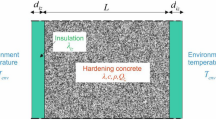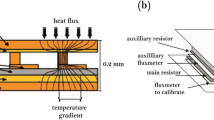Abstract
This paper presents some experimental and numerical results on the study of the hygrothermal behavior of the High Performance Concrete used to build the inner wall of the nuclear power station of CIVAUX 2 (in France). In the laboratory, accidental situations (beyond design) have been considered. The scenario, designated as Severe Accident (SA), consisted of a rise from ambient conditions to 200°C, and a steam pressure of 1.3 MPa in 24 hours, maintained after several hours. Those conditions were applied on one face of a specimen, the other one being in ambient temperature. A cylindrical specimen with 1.3 m of thickness was used. Thermocouples, pressure taps, and moisture meters were implanted in the concrete at the moment of casting. They gave local information; most of them are distributed in the first 0.30 m. The typical experimental results of the evolution of the temperature, the pressure and water content as a function of time, are shown for the testing conditions. The thickness of the wall affected by accident was determined. A wetting of the concrete wall was observed, leading to a decrease of the permeability of the concrete. No outgoing gas was measured through the specimen under the action of thermal and pressure gradients. The test results are compared to a numerical model using a modified version of the TEMPOR.2 program developed by Bazant.
Similar content being viewed by others
References
H.P. Lien, and F.H. Wittmann, “Coupled Heat and Mass Transfer in Concrete Elements at Elevated Temperatures,” Nucl. Eng. Des., vol. 156, 1995, pp. 109–119.
G.L. England and N. Khoylou, “Modelling of Moisture Behavior in Normal and High Performance Concrete at Elevated Temperatures,” in Proceeding of 4th Weimar Workshop on High Performance Concrete: Material Properties and Design, Weimar, Germany, 1995, pp. 53–67.
O. Kontani and S.P. Shah, “Pore Pressure in Sealed Concrete at Sustained High Temperatures,” in Proceeding of Concrete Under Severe Conditions: Environment and Loading, Tokyo, Japan, 1995, pp. 1151–1162.
L. Granger, M. Shekarchi, and J.P. Touret, “Leak Tightness of HPC in Accidental Conditions—EDF Strategy in Terms of R&D,” in Proceeding of International Symposium on High Performance Concrete and Reactive Powder Concretes, Sherbrooke, Canada, 1998, pp. 227–242.
F. de Larrard, G. Ithurralde, P. Acker, and D. Chauvel, “High Performance Concrete for Nuclear Containment,” in Proceeding of the Second International Symposium on High-Strength Concrete, Berkeley: ACI SP-121, 1990, pp. 549–576.
M. Shekarchi, G. Debicki, P. Clastres, and Y. Billard, “Influence of Silica Fume on Permeability of Concrete to Oxygen for Temperatures up to 500°C,” Sixth CANMET/ ACI International Conference on Fly Ash, Silica Fume, Slag and Natural Pozzolans in Concrete, Bangkok, Thailand, 1998, pp. 975–996.
M. Shekarchi, G. Debicki, R. Briot, and P. Clastres, “Non-Destructive Technique for Measurement of Water Content in the Concrete Wall with Hygrothermal Gradients,” in Proceeding of the RILEM Int. Con. on Non-Destructive Testing and Experimental Stress Analysis of Concrete Structures, Kosice, Slovak Republic, 1998, pp. 330–334.
Z.P. Bazant and W. Thonguthai, “Pore Pressure and Drying of Concrete at High Temperature,” Journal of Engrg. Mechs., EM5, 1978, pp. 1059–1079.
G. Dhatt, M. Jacquemier, and C. Kadje, “Modelling of Drying Refractory Concrete,” in Proceeding of 5th Int. Symp. on Drying, McGill University, 1986, pp. 94–104.
P. Majumdar, A. Gupta, and A. Marchertas, “Moisture Propagation and Resulting Stress in Heated Concrete Walls,” Nucl. Eng. Des., vol. 156, 1995, pp. 147–158.
M. Shekarchi, G. Debicki, L. Granger, and P. Clastres, “High Performance Concrete Behavior Under Accident Conditions,” in Proceeding of 5th International Workshop on Material Properties and Design Durable Reinforced Concrete Structures, Weimar, Germany, 1998, pp. 283–300.
E.H. Atlassi, “Nonevaporable Water and Degree of Cement Hydration in Silica Fume-Cement System,” in 5th CANMET/ACI International Conference on Fly Ash, Silica Fume, Slag and Natural Pozzolans in Concrete, vol. 2, Milwaukee, Wisconsin, 1995, pp. 703–717.
J.C. Maréchal, “Conductivité Thermique des Matériaux du Bâtiment,” Annales de l'ITBTP, no. 185, 1963, pp. 435–442.
H. Abe, T. Kawahara, T. Ito, and A. Haraguchi, “Influence Factors of Elevated Temperatures on Thermal Properties and Inelastic Behavior of Concrete,” in Concrete for Nuclear Reactors, ACI SP, no. 34, Paper SP34–40, ACI, Detroit, 1972, pp. 847–870.
J. Piasta, Z. Sawicz, and L. Rudzinski, “Changes in the Structure of Hardened Cement Paste Due to High Temperature,” Matériaux et Constructions, no. 100, 1984, pp. 291–296.
Author information
Authors and Affiliations
Rights and permissions
About this article
Cite this article
Shekarchi, M., Debicki, G., Billard, Y. et al. Heat and Mass Transfer of High Performance Concrete for Reactor Containment Under Severe Accident Conditions. Fire Technology 39, 63–71 (2003). https://doi.org/10.1023/A:1021779210983
Issue Date:
DOI: https://doi.org/10.1023/A:1021779210983




